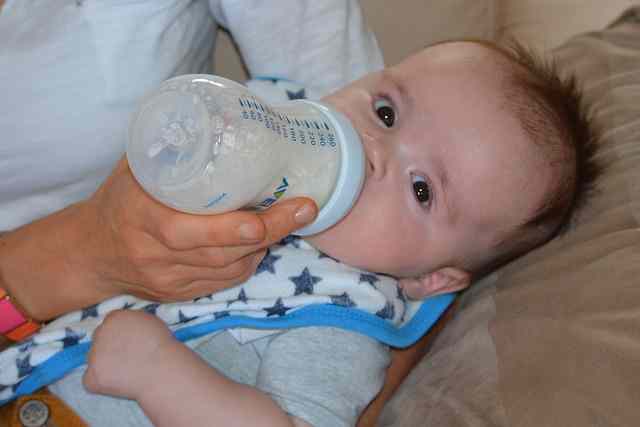When we first brought our little baby boy from the hospital, one of our first concerns were how to make sure that his bottles were ready. We were worried that maybe they weren’t clean enough and might make him sick. How do we sterilize them and ensure they are safe? After we use them, do we need to sterilize them after every use?
Sterilizing bottle is a critical step to ensure they do not contain harmful bacteria for your baby. There are several ways to sterilize bottles such as steam, boiling, and chemical disinfectants. Bottles must remain sterile until a baby’s immune system is strong enough.
Why do babies need sterile bottles?
Newborn babies do not have much of an immune system. Up to the moment of their birth they have been relying on the immune system of their mother to keep them safe. Once they are born however, they are largely on their own. They do still have antibodies of their mother in their system, but that cannot provide them with complete protection. Typically immune protection passed at birth only lasts up to a few weeks.
If a mother is able to provide breast milk to their child, then the child will still receive some protection from antibodies in the milk. That though is still limited to the immunity of the mother. If a child is exposed to something that the mother doesn’t have antibodies for, then the child won’t have protection.
Bottles can easily have a variety of bacteria growing in it. When you bring the bottles home from the store, you have no idea where those bottles have been or what they have been in contact with. There could be any number of bacteria in the bottles from the manufacturing plant.
After bottles are used, if they are not dried well, they could have bacteria growing in the water that remains in the bottle. All of this bacteria needs to be killed to prevent it from infecting your little baby.
How long should I continue to sterilize bottles?
It can take your baby around three months to develop a mature immune system. Some babies will have it sooner, others will take a little longer. Three months though is the usual amount of time.
Before the three months are up, you need to be very careful about anything which might lead to an infection in your baby. They just won’t be equipped to handle it. Even after three months, they still will struggle to fight an infection but at least their little bodies will have the tools to fight.
So all that being said, you should continue to sterilize bottles for at least those three months. Some organizations recommend that you sterilize bottles for the first twelve months as extra protection against illness. I don’t know if you’ve ever cared for an ill infant. If you haven’t, it’s scary. It’s definitely something you want to avoid at all costs.
What are some ways to sterilize bottles?
There are three main ways to sterilize bottles: steam, boiling, and chemical disinfectants. No matter what method you pick, be sure to follow any and all manufacturer instructions to ensure that the sterilization process is completed successfully.
Here are some manufacturer specific sterilization instructions. If you cannot find instructions from the manufacturer of your bottle, then you can take a look below for general sterilization instructions.
Medela bottle sterilization instructions
NUK bottle sterilization instructions
Philips Avent bottle sterilization instructions
General sterilization instructions
Steam
Steam sterilization works by raising the temperature of the air around the bottles high enough to kill any germs living on the surface. Because steam is used to kill the germs, you should always keep the bottles upside down to avoid any pooling of water in the bottles.
Often you perform the sterilization inside a special sterilization container, like this one I use from Amazon . You since the inside of these containers are sterilized along with the bottles, you should leave the bottles inside the container until you need to use them.
. You since the inside of these containers are sterilized along with the bottles, you should leave the bottles inside the container until you need to use them.
There are many germs which can be spread through the air. Because of this, the bottle sterilization won’t last forever. If you’re not going to use the bottles within a day or two of the sterilization, you should sterilize them again just before you need to use them.
Boiling
Sterilization through boiling follows the same principle as the steam method. You want to heat up the space around the bottles to a high enough temperature to kill any germs on the bottles.
Unlike the stem method however, you want water everywhere around the bottles. This means you put the bottles right side up and have enough water to complete cover everything being sterilized.
First you put water into a pot on the stove and add all items to be sterilized. Like I said earlier, you want everything covered with water, so make sure there are no air bubbles in the bottles. You also need to make sure the bottles are completely covered by the water. If your pot is too small to completely cover the bottles, then you’ll either need to find a taller pot or use a different sterilization method.
After everything has been added, bring the water to a boil. Once the water is boiling, you should leave it that way for at least five minutes. This will help ensure everything harmful is killed. After five minutes is up, you can turn off the heat and let everything cool down.
Since you probably don’t want to leave the bottles in the pot long term, you should have another spot to store them. Be careful to disinfect the storage location though, since you don’t want to infect those bottles you just cleaned.
If you don’t use the bottles within a day, you should sterilize them again just to be certain that the bottles were not infected again by anything airborne.
Chemical Disinfectants
When it comes to chemical disinfectants, there’s fewer general rules than with the other methods. All disinfectants should come with specific instructions on how to use them. Be sure to read them and follow every step carefully.
Generally speaking though, you’ll use the disinfectant to create a disinfecting solution. Then the bottles will be submerged into this solution. After the sterilization is complete, you’ll likely need to discard all of the disinfecting solution.
What should I do if I’m not able to sterilize the bottles?
Even with careful preparation, you’re not always going to be in a position where you can sanitize bottles. Maybe the electricity is out at your home, or you are traveling and don’t have a stove or microwave.
In this case complete sterilization is unlikely, so you’ll need to focus on cleaning the bottles as well as possible. Use soapy water and a bottle brush to scrub the bottles and remove all remnants of formula or breast milk. After the bottles have been scrubbed, you should thoroughly rinse them and leave them in a clean space to dry.

